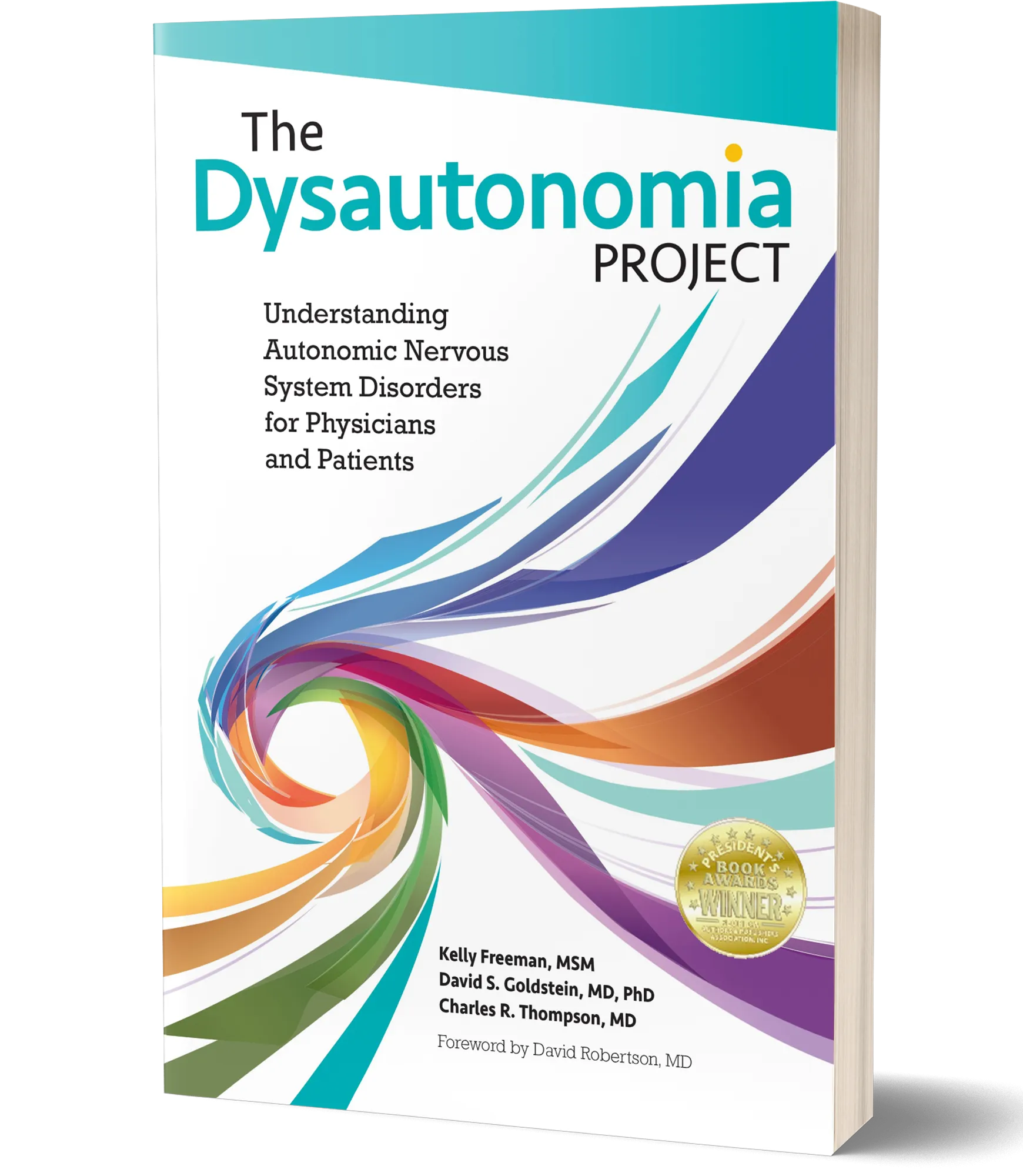If you’re dealing with the frustration of misdiagnoses on top of the pain and life changes brought on by your symptoms, you’re not alone. Many dysautonomia patients know the struggle of living with unexplained symptoms, multiple misdiagnoses, and being told it’s all in their head. Until recently, it took an average of six years for an accurate diagnosis. Although the gap between symptom onset and diagnosis is decreasing, there is still work to be done.
Do you have dysautonomia? That’s not a question TDP can answer for you, but we can help you as you look for answers and a diagnosis.
What is dysautonomia?
Dysautonomia (dis-auto-NO-mia) is an umbrella term used to describe any disorder of the autonomic (or automatic) nervous system. The autonomic nervous system is the part of the nervous system that regulates functions that are automatic in nature such as heart rate, blood pressure, digestion, excretion, perspiration, temperature regulation, pupil dilation, circulation, and respiration among others.
The autonomic nervous system is responsible for maintaining homeostasis, or equilibrium, in the body. When there is dysfunction or failure of the autonomic nervous system, the result is a disorder classified as a type of dysautonomia. These disorders can be mild to debilitating, and usually involve abnormal symptoms in many organ systems, including cardiac, gastrointestinal, neurological, and pulmonary, as well as others.
If you think you might have some form of dysautonomia, here are steps you can take.
- Know the symptoms of dysautonomia.
- Take the Autonomic Disorders Assessment for Undiagnosed Patients
- If the symptom descriptions fit your symptoms, find a provider who can diagnose you.
- Get a copy of our definitive guide on dysautonomia, The Dysautonomia Project, and take it to your provider with your symptom assessment list.
- Be prepared for your appointment.
- Let us help you learn about dysautonomia.
- Remember, you are not alone.

KNOW THE SYMPTOMS OF DYSAUTONOMIA
The symptoms experienced by dysautonomia patients vary based on the type of autonomic dysfunction and where the dysfunction is occurring within the body. Because dysautonomia affects multiple organ systems, the presentation of symptoms can be heterogenous, widely varying between individuals. For example, one patient with POTS, the most common form of dysautonomia, may have the chief complaint of abdominal pain while the next POTS patient complains most about migraine headaches. The organ systems most commonly affected in POTS are neurological, pulmonary, cardiovascular, urinary, gastrointestinal, secretomotor and pupillomotor. One interesting common sign of autonomic dysfunction is the difficulty maintaining upright posture, also known as orthostatic intolerance.
The top seven signs and symptoms of dysautonomia include:
- Difficulty standing still
- Fatigue
- Lightheadedness
- Nausea and other GI symptoms
- Brain fog or mental clouding
- Palpitations or chest discomfort
- Shortness of breath or difficulty breathing
This is not an exhaustive list of dysautonomia symptoms. However, they are some of the most common. It’s possible to simplify this list down to these three indicators:
- Dizziness or lightheadedness when you stand up. You do not have to faint to have dysautonomia. In fact, most dysautonomia patients do not experience syncope (clinical term for fainting).
- Symptoms in multiple organ systems (i.e., cardiovascular, pulmonary, gastrointestinal, neurological)
- Abnormal orthostatic vitals: The orthostatic vitals test is used to evaluate the body’s response to a change in position. It examines changes in your heart rate and blood pressure when you are resting, sitting, and standing. The test can reveal how your body responds to orthostatic (upright) stress.
TAKE THE AUTONOMIC DISORDERS ASSESSMENT:
Do the symptoms listed above describe you? If so, take advantage of our Autonomic Disorders Assessment. This free, educational assessment allows undiagnosed patients to screen their symptoms to determine if they have a higher or lower risk for an autonomic disorder. Patients can print a report that summarizes their symptoms and take it to their provider. We encourage individuals to repeat this assessment in the future to identify trends in health by saving a copy of this assessment report, and review the results with your health care provider.
FIND A PROVIDER
It’s critical to find a provider that understands dysautonomia. TDP has compiled an up-to-date list of providers who see patients with dysautonomia. Our Find a Provider database includes providers from across the United States.
BE PREPARED FOR YOUR APPOINTMENT
- Bring a complete list of your symptoms. Have a copy of this list to give to your provider for your patient records. Document when the symptoms started, their severity, and their frequency.
- Come with a list of the questions you have for the provider. Ask a family member to look over the list to make sure you’ve included everything. One of those questions should be if they are familiar with autonomic nervous system dysfunction.
- Make copies of any relevant medical records and lab results if you have them available and give them to your provider.
- Don’t be surprised if your provider can’t conduct a complete autonomic disorder assessment in this first appointment. You may have to schedule a follow-up appointment.
- These tips and more are found in our article: Preparing for Your Medical Appointments.
GET A COPY OF THE DEFINITIVE GUIDE ON DYSAUTONOMIA
The Dysautonomia Project was first published in 2015. It was written by a patient and physicians for patients and physicians. It was the first of its kind and has helped to bridge the gap between what autonomic specialists know and what patients and community-based providers need to know. It is our definitive guide on dysautonomia to date. We highly recommend taking the book to your provider and keeping a copy for yourself.
We share the highlights of the book throughout the website and a few chapters in our Patient Education Center, so dysautonomia patients can start taking steps the path toward hope. The book is comprehensive and compiles all the information in one place. When you’re ready to dive deeper into the content, you can take that step. In the meantime, let us help you learn the basics about autonomic dysfunction right here on this site.

LEARN WHAT YOU CAN ABOUT DYSAUTONOMIA
Our mantra at TDP is that education is the number one treatment. It’s why we exist. We encourage you to start with these articles:
REMEMBER, YOU ARE NOT ALONE
TDP was founded by a patient to bring hope and support to patients. One of our goals is help decrease the time it takes for patients to get diagnosed and to educate patients and community-based providers. We know the challenges patients face. We also know that education is the key to empowering patients as they advocate for their health. Check out our Patient Education Center for more articles and videos.
































One Response
I read the book about 1 1/2 to 2 years ago. It was so helpful! I wish I could afford to buy a bunch of copies to give to give the many health care providers that we have had horrible experiences with. Myself, my son and my daughter have all been diagnosed with dysautonomia in past 2 years. My son is the sickest and has been sick for 7 years. He is basically house bound. We are working on getting into Mayo Clinic for all of us. My son had an appointment for Vanderbilt but we were unable to travel because he was too sick and we can’t get doctors to really help with appropriate meds needed to get him there. I’m constantly looking for education and doctors and forgot about this site. So happy to explore and hopefully find what we need. Because we are desperate!